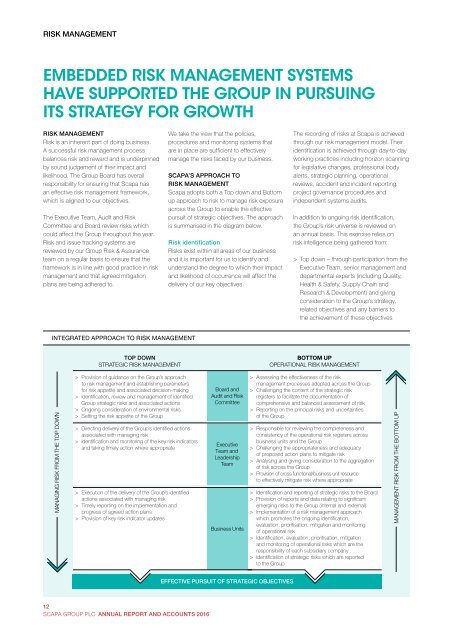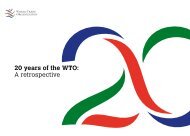20645_Scapa_AR_160504
You also want an ePaper? Increase the reach of your titles
YUMPU automatically turns print PDFs into web optimized ePapers that Google loves.
RISK MANAGEMENT<br />
EMBEDDED RISK MANAGEMENT SYSTEMS<br />
HAVE SUPPORTED THE GROUP IN PURSUING<br />
ITS STRATEGY FOR GROWTH<br />
RISK MANAGEMENT<br />
Risk is an inherent part of doing business.<br />
A successful risk management process<br />
balances risk and reward and is underpinned<br />
by sound judgement of their impact and<br />
likelihood. The Group Board has overall<br />
responsibility for ensuring that <strong>Scapa</strong> has<br />
an effective risk management framework,<br />
which is aligned to our objectives.<br />
The Executive Team, Audit and Risk<br />
Committee and Board review risks which<br />
could affect the Group throughout the year.<br />
Risk and issue tracking systems are<br />
reviewed by our Group Risk & Assurance<br />
team on a regular basis to ensure that the<br />
framework is in line with good practice in risk<br />
management and that agreed mitigation<br />
plans are being adhered to.<br />
We take the view that the policies,<br />
procedures and monitoring systems that<br />
are in place are sufficient to effectively<br />
manage the risks faced by our business.<br />
SCAPA’S APPROACH TO<br />
RISK MANAGEMENT<br />
<strong>Scapa</strong> adopts both a Top down and Bottom<br />
up approach to risk to manage risk exposure<br />
across the Group to enable the effective<br />
pursuit of strategic objectives. The approach<br />
is summarised in the diagram below.<br />
Risk identification<br />
Risks exist within all areas of our business<br />
and it is important for us to identify and<br />
understand the degree to which their impact<br />
and likelihood of occurrence will affect the<br />
delivery of our key objectives.<br />
The recording of risks at <strong>Scapa</strong> is achieved<br />
through our risk management model. Their<br />
identification is achieved through day-to-day<br />
working practices including horizon scanning<br />
for legislative changes, professional body<br />
alerts, strategic planning, operational<br />
reviews, accident and incident reporting,<br />
project governance procedures and<br />
independent systems audits.<br />
In addition to ongoing risk identification,<br />
the Group’s risk universe is reviewed on<br />
an annual basis. This exercise relies on<br />
risk intelligence being gathered from:<br />
> > Top down – through participation from the<br />
Executive Team, senior management and<br />
departmental experts (including Quality,<br />
Health & Safety, Supply Chain and<br />
Research & Development) and giving<br />
consideration to the Group’s strategy,<br />
related objectives and any barriers to<br />
the achievement of these objectives<br />
INTEGRATED APPROACH TO RISK MANAGEMENT<br />
TOP DOWN<br />
STRATEGIC RISK MANAGEMENT<br />
BOTTOM UP<br />
OPERATIONAL RISK MANAGEMENT<br />
MANAGING RISK FROM THE TOP DOWN<br />
> Provision of guidance on the Group’s approach<br />
to risk management and establishing parameters<br />
for risk appetite and associated decision-making<br />
> Identification, review and management of identified<br />
Group strategic risks and associated actions<br />
> Ongoing consideration of environmental risks<br />
> Setting the risk appetite of the Group<br />
> Directing delivery of the Group’s identified actions<br />
associated with managing risk<br />
> Identification and monitoring of the key risk indicators<br />
and taking timely action where appropriate<br />
> Execution of the delivery of the Group’s identified<br />
actions associated with managing risk<br />
> Timely reporting on the implementation and<br />
progress of agreed action plans<br />
> Provision of key risk indicator updates<br />
Board and<br />
Audit and Risk<br />
Committee<br />
Executive<br />
Team and<br />
Leadership<br />
Team<br />
Business Units<br />
> Assessing the effectiveness of the risk<br />
management processes adopted across the Group<br />
> Challenging the content of the strategic risk<br />
registers to facilitate the documentation of<br />
comprehensive and balanced assessment of risk<br />
> Reporting on the principal risks and uncertainties<br />
of the Group<br />
> Responsible for reviewing the completeness and<br />
consistency of the operational risk registers across<br />
business units and the Group<br />
> Challenging the appropriateness and adequacy<br />
of proposed action plans to mitigate risk<br />
> Analysing and giving consideration to the aggregation<br />
of risk across the Group<br />
> Provision of cross functional/business unit resource<br />
to effectively mitigate risk where appropriate<br />
> Identification and reporting of strategic risks to the Board<br />
> Provision of reports and data relating to significant<br />
emerging risks to the Group (internal and external)<br />
> Implementation of a risk management approach<br />
which promotes the ongoing identification,<br />
evaluation, prioritisation, mitigation and monitoring<br />
of operational risk<br />
> Identification, evaluation, prioritisation, mitigation<br />
and monitoring of operational risks which are the<br />
responsibility of each subsidiary company<br />
> Identification of strategic risks which are reported<br />
to the Group<br />
MANAGEMENT RISK FROM THE BOTTOM UP<br />
EFFECTIVE PURSUIT OF STRATEGIC OBJECTIVES<br />
12<br />
SCAPA GROUP PLC ANNUAL REPORT AND ACCOUNTS 2016
















